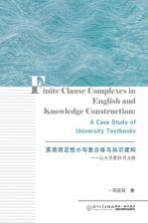

英语限定性小句复合体与知识建构 以大学教科书为例PDF电子书下载
- 电子书积分:10 积分如何计算积分?
- 作 者:邓庆环著
- 出 版 社:厦门:厦门大学出版社
- 出版年份:2015
- ISBN:9787561554357
- 页数:245 页
Chapter 1 Introduction 1
1.1 Background of the Study 1
1.1.1 Functions of Logical Elements in Knowledge Construction 2
1.1.2 Complex Sentences and Knowledge Construction 3
1.2 Rationale of the Study 8
1.3 Research Objectives and Questions 11
1.4 Data Collection and Methodology 12
1.5 Organization of the Book 16
Chapter 2 Literature Review 18
2.1 Review of Studies of FCCs 18
2.1.1 Traditional Approaches to FCCs 18
2.1.2 Cognitive Linguistics 21
2.1.3 Systemic Functional Linguistics 24
2.1.4 Comment on These Approaches 33
2.2 Review of Studies of Coniunctions 35
2.2.1 Traditional Grammar 35
2.2.2 Systemic Functional Linguistics 37
2.2.3 Comment on These Approaches 44
2.3 Studies of TBs 46
2.3.1 Academic Status of TBs 46
2.3.2 A Survey of Studies ofTBs 47
2.4 Summary 49
Chapter 3 Theoretical Framework 50
3.1 KeyNotions 50
3.1.1 Metafunctions 51
3.1.2 Choice and Probabilistic 54
3.1.3 Register 55
3.1.4 Genre 58
3.1.5 Academic Language Socialization 61
3.1.6 Constructive Perspective on Knowledge 62
3.1.7 Knowledge Construction in TBs 64
3.1.8 Explanation and Verbal Reasoning 66
3.1.9 Brief Comment on These Notions 69
3.2 Analytic Framework 70
3.2.1 Expansive FCCs 72
3.2.2 Projective FCCs 74
3.2.3 Conjunctions 75
3.2.4 Projecting Verbs 77
3.2.5 Projectors 78
3.3 Reasons for Choosing SFL 79
3.4 Summary 81
Chapter 4 Expansive FCCs and Knowledge Construction(1):Extensive FCCs and Elaborative FCCs 82
4.1 Elaborative and Extensive FCCs in Knowledge Construction 82
4.2 Details of Extensive FCCs in the Sub-Corpora 85
4.3 Extensive FCCs and Knowledge Construction 87
4.3.1 Paratactic Extensive FCCs and Their Functions 88
4.3.2 Hypotactic Extensive FCCs and Their Functions 101
4.4 Elaborative FCCs and Knowledge Construction 102
4.4.1 Elaborative FCCs in TBs 102
4.5 Comparison of Extensive FCCs and Elaborative FCCs 111
4.6 Summary 113
Chapter 5 Expansive FCCs and Knowledge Construction(2):Enhancement FCCs 114
5.1 Enhancement FCCs and Conjunctions 115
5.2 Overall Features of Enhancement FCCs in TBs 119
5.3 Causal Relation and Knowledge Construction 124
5.3.1 Frequencies ofCausal Relation in the Corpus 124
5.3.2 Causal Relation and Knowledge Construction 127
5.3.3 Organizations ofCause and Effect 132
5.4 Conditional Relation and Knowledge Construction 136
5.4.1 Studies ofConditionals 136
5.4.2 Quantitative Results of Conditionals and Their Functions 139
5.5 Concessive Relation and Knowledge Construction 145
5.6 Temporal Relation and Knowledge Construction 148
5.7 Manner Realtion and Knowledge Construction 151
5.8 Comparison of Disciplinary Features of Enhancement FCCs 154
5.9 Summary 157
Chapter 6 Projective FCCs and Knowledge Construction 159
6.1 Projective FCCs in TBs 159
6.2 Features of Projectors 162
6.2.1 Classification of Projectors 162
6.2.2 Overall Features ofProjectors in TBs 165
6.2.3 Projectors and Knowledge Construction 171
6.2.4 Comment on Projectors in TBs 178
6.3 Projecting Verbs and Knowledge Construction 179
6.3.1 Studies ofProjecting Verbs 179
6.3.2 Classification ofProjecting Verbs 182
6.3.3 Projecting Verbs and Knowledge Construction 187
6.3.4 Modality and Tense in Projective FCCs and Their Function 194
6.4 Interaction Between Projectors and Projecting Verbs 202
6.5 Summary 208
Chapter 7 Conclusion 210
7.1 Quantitative Results and Discussion 210
7.2 Significance of the Current Study 215
7.3 Limitations and Suggestions 219
Appendix Data Samples 220
Phycorp 220
Extract 1 220
Extract 2 221
Extract 3 221
Psycorp 222
Extract 1 222
Extract 2 223
Extract 3 224
Ecocorp 225
Extract 1 225
Extract 2 225
Extract 3 226
References 228
致谢 245
- 《名医教你练走颈肩腰腿痛》许学猛 2018
- 《博士教你识中药》(中国)黄汉超 2019
- 《保教知识与能力》师大教科文教材编写组编著 2020
- 《批判 建构与实践 戴维·佩珀生态社会主义思想研究》梅丽著 2019
- 《教自闭症孩子主动发起和自我管理 应用关键反应训练提高社交技能》(美)Lynn Kern Koegel,(美)Robert L. Koegel著 2019
- 《纳米颗粒复合电刷镀技术及应用》董世运著 2019
- 《英语可以这样教 修订版》沈丽新著 2019
- 《高等数学大学同步辅导教 同济7版教材配套 上》汤家凤编著 2017
- 《余生很贵,请多指教》雾都摇篮著 2019
- 《国际格局变化与中国 建构主义理论的新视角》王庆新著 2019
- 《大学计算机实验指导及习题解答》曹成志,宋长龙 2019
- 《大学生心理健康与人生发展》王琳责任编辑;(中国)肖宇 2019
- 《大学英语四级考试全真试题 标准模拟 四级》汪开虎主编 2012
- 《大学英语教学的跨文化交际视角研究与创新发展》许丽云,刘枫,尚利明著 2020
- 《复旦大学新闻学院教授学术丛书 新闻实务随想录》刘海贵 2019
- 《大学英语综合教程 1》王佃春,骆敏主编 2015
- 《大学物理简明教程 下 第2版》施卫主编 2020
- 《大学化学实验》李爱勤,侯学会主编 2016
- 《中国十大出版家》王震,贺越明著 1991
- 《近代民营出版机构的英语函授教育 以“商务、中华、开明”函授学校为个案 1915年-1946年版》丁伟 2017
